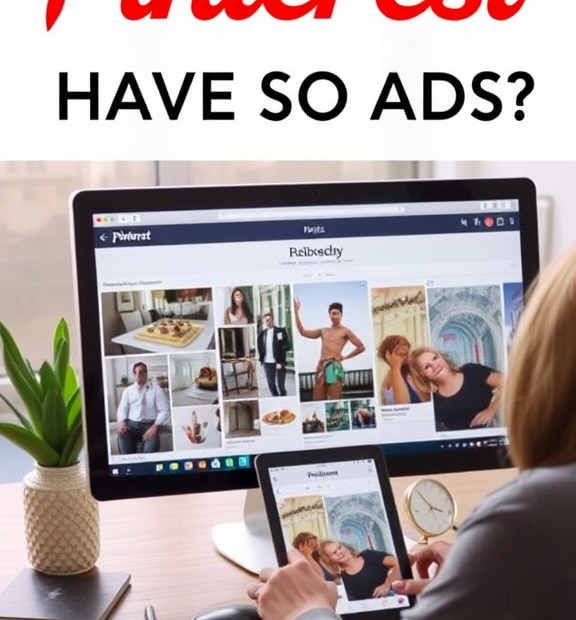The Rise of Ads on Pinterest: Understanding the Platform’s Monetization Strategy
Pinterest has transformed from a simple platform for sharing images and ideas into a bustling marketplace filled with advertisements. If you’ve browsed Pinterest lately, you may have noticed an increase in ads. But why is this happening? Let’s dive into Pinterest’s monetization strategy and uncover the reasons behind the rise of ads on this platform.
The Growing Demand for Revenue
As Pinterest continues to grow in users and engagement, so does the need for revenue. The platform is not just a social media site; it is a business. Generating income allows Pinterest to enhance user experience, improve its technology, and offer better services to its users.
User Demographics and Engagement
Pinterest attracts a highly engaged user base, making it an attractive spot for advertisers. The platform primarily caters to individuals looking for inspiration, ideas, or products. Many users come to Pinterest with the intent to shop, which is a goldmine for brands. With over 450 million monthly active users, advertisers see Pinterest as an opportunity to reach a vast audience that is already in a shopping mindset.
Creating a Seamless Advertising Experience
One of the essential aspects of Pinterest’s advertising strategy is creating a seamless experience for users. Ads on Pinterest are designed to blend in with organic content, making them less intrusive. Here are some types of ads you might encounter:
- Promoted Pins: These are regular pins that businesses pay to promote, appearing in users’ feeds while looking just like standard content.
- Video Pins: These dynamic ads can capture users’ attention more effectively. They allow brands to tell a story and showcase products in-action.
- Shopping Ads: These ads showcase specific products, allowing users to make purchases directly through Pinterest.
Targeting Capabilities
Another reason for the surge in ads is the advanced targeting capabilities Pinterest offers advertisers. Brands can target users based on:
- Interests: This allows advertisers to reach users who are likely to engage with their products based on personal interests.
- Demographics: Advertisers can choose to target by age, gender, and location, tailoring ads to fit specific audiences.
- Keywords: Ads can appear in search results when users look for specific terms, making them more relevant.
The Shift Towards E-Commerce
Pinterest has been steering toward a more commerce-focused environment. By integrating shopping features directly into the platform, Pinterest enables a smoother purchasing journey. Recently, they’ve introduced buyable pins and shoppable catalogs, where brands can showcase their products, further increasing advertisement visibility. This shift is appealing not just to users, but also to the brands that want to convert Pinterest engagement into sales.
Analyzing User Behavior
The platform employs sophisticated algorithms to study user interactions. By tracking pins saved, re-pinned, and clicked on, Pinterest can offer advertisers insights into user preferences. This data allows brands to tailor their ads to fit user interests even more precisely, making them more appealing and effective. The better the ads perform, the more revenue Pinterest can generate—creating a cycle of success for both the platform and the advertisers.
The Future of Advertising on Pinterest
Love what I do? Be a hero and help me keep creating awesome content!
Support My Mission Now!Every donation fuels more great stuff – thank you, legend!
As Pinterest continues to evolve, its advertising strategies will likely expand. With innovations in augmented reality (AR) and machine learning, the platform may further personalize ad experiences. Users could engage with ads in more interactive ways, enhancing the user experience while simultaneously driving revenue for the business.
The rise of ads on Pinterest is a result of its growing demand for monetization, user engagement, and a seamless advertising experience. By understanding these elements, you can appreciate the strategic approach Pinterest takes in weaving advertising into the fabric of its platform. It’s not just about selling ads; it’s about creating a place where users find inspiration and brands make meaningful connections.
How Pinterest Ads Impact User Experience and Content Discovery
Love what I do? Be a hero and help me keep creating awesome content!
Support My Mission Now!Every donation fuels more great stuff – thank you, legend!
Pinterest has become a pivotal platform for inspiration, creativity, and content discovery. As you scroll through your feed, it’s hard to miss the amount of ads that have increasingly populated the user experience. So, why does Pinterest have so many ads? The answer is rooted in its business model and user engagement goals. Let’s explore how Pinterest ads impact user experience and content discovery.
Understanding Pinterest’s Advertising Model
Pinterest operates primarily on a free model, allowing users to browse and discover ideas without subscribing or paying fees. However, the platform needs revenue to maintain and enhance its features. This necessity leads to the incorporation of ads into the user experience.
Pinterest offers various advertising formats, including:
- Promoted Pins: These appear just like regular pins but are backed by ad budget. They reach a wider audience based on interests and behaviors.
- Video Pins: Engaging and dynamic, these ads utilize video content to catch users’ attention.
- Shopping Ads: These help brands sell products directly through interactive and visually appealing methods.
Love what I do? Be a hero and help me keep creating awesome content!
Support My Mission Now!Every donation fuels more great stuff – thank you, legend!
Including these ads ensures not only revenue generation but also keeps the platform vibrant with fresh content.
The Role of Personalization
One notable strength of Pinterest is its ability to personalize content for users. Pinterest’s algorithm curates content based on user interests, behavior, and previous interactions. When ads are integrated into this ecosystem, they often align with users’ preferences. Customization makes ads less intrusive and more of a natural part of the browsing experience.
Love what I do? Be a hero and help me keep creating awesome content!
Support My Mission Now!Every donation fuels more great stuff – thank you, legend!
You might notice that the ads you see often echo your latest searches or pins. This relevancy helps to enhance your overall experience rather than detract from it. When you engage with ads that align with your interests, you’re likely to discover more content and products you genuinely want.
Impact on Content Discovery
Ads on Pinterest impact discovery in various ways:
- Increased Exposure: Brands can showcase their content to targeted audiences, increasing visibility for unique ideas and products.
- Boosted Creativity: Well-crafted ads can inspire you by presenting innovative uses for products or fresh ideas that you might not have encountered otherwise.
- Product Education: Ads often offer how-tos, guides, or tips, enhancing your understanding of a product’s benefits. This educational aspect of ads contributes to a more informative browsing experience.
Challenges of Excessive Advertising
While ads can enrich your Pinterest journey, an overwhelming number can lead to challenges. Excessive advertisements might clutter the user interface, making it harder to find inspiration or discover new content. When ads feel more frequent than organic pins, it may frustrate users.
You may find yourself scrolling past ads rather quickly, which defeats their intended purpose. This phenomenon could lead to decreased user engagement with those advertisements, prompting businesses to rethink their strategies.
Finding a Balance
The key lies in finding a balance between ads and organic content. Pinterest is aware of this dynamic. Therefore, their algorithms continually adjust to serve ads that fit better within users’ interests while prioritizing the exposure of organic content.
You can also engage with the ads that resonate with you, creating a unique and tailored feed. By saving pins from ads that you like, you signal to Pinterest that you want to see more similar content, promoting a personalized browsing experience.
Looking Ahead
As Pinterest continues to evolve, so will its approach to advertising. You can anticipate innovations that enhance user experience and content discovery, ensuring ads remain relevant and engaging. The dual purpose of ads as both revenue sources and discovery tools will maintain Pinterest’s uniqueness in the social media landscape.
So next time you notice a slew of ads on your Pinterest feed, remember that they’re intricately woven into your experience, serving both your interests and Pinterest’s need to cultivate revenue. Navigating this landscape can lead to a richer, more engaging journey on the platform. Simply put, embracing the ads can unlock new levels of inspiration for your creative pursuits.
Conclusion
As Pinterest continues to evolve, its monetization strategy through increased advertising presence reflects broader trends in social media and digital marketing. The rise of ads on the platform is not simply about profit; it’s about helping brands connect with users who are already in a mindset for inspiration and discovery. These ads are designed to blend seamlessly with regular Pins, providing a unique opportunity for users to encounter new products and ideas that align with their interests.
Love what I do? Be a hero and help me keep creating awesome content!
Support My Mission Now!Every donation fuels more great stuff – thank you, legend!
However, while Pinterest’s move towards more ads can enhance the relevance of content for users, it also poses challenges for the overall user experience. Users may find the increased ad load overwhelming or intrusive, potentially detracting from the joy of pinning and exploring. For content creators and brands, striking a balance between compelling advertising and authentic user engagement becomes crucial. It’s essential for Pinterest to continue refining its approach so that ads serve to enrich the user experience instead of detracting from it.
Ultimately, the successful integration of advertising into the Pinterest ecosystem relies on understanding user behavior and preferences. As users become accustomed to curated ads that resonate with their interests, the platform can maintain its reputation as a valuable source of inspiration while also supporting the brands that contribute to its vibrant community. By prioritizing a thoughtful and user-centric approach, Pinterest can foster an environment where ads enhance rather than hinder the creative journey of its users.

